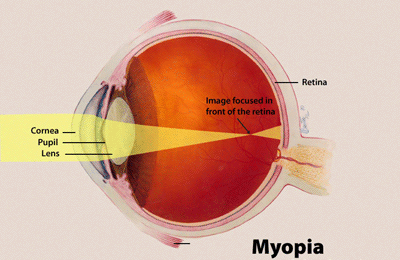Pandemic will accelerate the myopia epidemic, experts warn
Even before the coronavirus pandemic, ophthalmologists and optometrists warned that a change in the lifestyle of the population, which is increasingly moving from the outdoor environment to the screens of digital devices, is likely to lead to a significant spread of myopia or also known as short-sightedness. Restrictions on free movement and online education for children of critical age are likely to accelerate this trend, which will have serious health and economic consequences that will persist long after the pandemic.
While current measures are temporary, and the coronavirus pandemic itself may disappear with the spread of the vaccine, some lockdown habits are likely to persist in our lives. Companies are closing office space because their home office has proved its worth, and some schools are considering introducing a hybrid (partly distance) form of teaching permanently. We will deal with the indirect consequences of the pandemic for much longer. Ophthalmologists and optometrists fear that more time spent at the screens, along with a decrease in outdoor activities, will significantly accelerate the progression of myopia.
"Myopia currently affects about a third of the population. It is manifested by poor distance vision and is caused by many factors and their combinations. Dispositions are often hereditary, the development of the disorder itself may be due to environmental influences. Studies suggest that these effects include close-up work. (activities that require close-up focusing such as reading or learning), working with digital devices that emit light, stress, eye strain and a decrease in outdoor activities, "explains Lentiamo optometrist Jakub Odcházel.
In most cases, myopia occurs around the age of six and stabilizes in adolescence, another "milestone" for the development of myopia is the 18th year of life. The lifestyle of schoolchildren and students therefore plays a crucial role. The trend of distance learning to replace schooling and digital technologies to become an indispensable part of teaching is therefore of concern to professionals. "Myopia cannot be completely cured, only corrected with diopters. People with myopia may experience other problems during their lifetime, such as retinal detachment, glaucoma, and the problem also occurs after forty, when many people develop presbyopia and the eye becomes worse "Severe forms of myopia can lead to low vision," warns.
These complications can be partially prevented by preventing and adjusting lifestyle. "Studies show that the prevalence of myopia is related to the length of study. The increase in myopia is faster in university students and also in the urban population. We believe that this is related to time spent outdoors, ie According to a foreign study, children who spent at least 11 hours a week outdoors have halved their risk of developing myopia, and parents and teachers need to be aware of this threat and ensure that their child spends as much time as possible. outside, and at home, they controlled the time spent at the screens, "advises Lentiamo, head of optics.
Preschool children are also at risk. The WHO recommends a maximum of one hour for digital screens per day for children aged 2 to 5, younger ones should not use them at all. For older children, it is good to find a compromise together with the parents, because the child rather follows the rules, the setting of which he agreed to. "If children spend 3 or more hours at the computer teaching, it is appropriate to limit recreational use of the computer," advises Jakub Odcházel.









